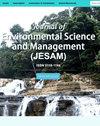基于多功能林业管理的海尔坎森林公路网设计
IF 0.3
4区 环境科学与生态学
Q4 ENVIRONMENTAL SCIENCES
引用次数: 3
摘要
传统上,林业管理的主要重点是木材生产,但最近转向多功能森林管理。多功能林业管理包括生态旅游、生态、森林居民的经济和社会问题以及木材生产等诸多考虑。基于多用途林业,利用GIS和SPOT-HRG卫星数据在达拉克拉森林进行森林道路设计。采用基于模糊逻辑的多准则评价方法对路网用地面积潜力进行评价。专家学者的意见被用来选择4个标准和18个子标准的道路设计。加权因子采用层次分析法(AHP)。采用加权线性组合(WLC)算子对各层进行组合,并对过马路电位图进行识别和分区。这条路是用PEGGER程序设计的。地理信息系统(GIS)和SPOT-HRG卫星数据是改善结果的有效工具。本研究采用加权线性组合(Weighted Linear Combination, WLC)模型,为今后的研究提供了多目标操作(multi - object operation, MOLA)的建议。本文章由计算机程序翻译,如有差异,请以英文原文为准。
Forest Road Network Design based on Multipurpose Forestry Management in Hyrcanian Forest
Traditionally, the main focus of forestry management has been based on wood production but more recently it is directed at multifunctional forest management. Multifunctional forestry management includes many considerations such as ecotourism, ecology, economic and social issues of forest dwellers as well as wood production. This study aims to design forest roads using GIS and satellite data of SPOT-HRG in the Darabkla forest based on Multipurpose Forestry. The study used the multi-criteria evaluation method based on fuzzy logic to assess the potential of land area for a road network. Opinions of experts and scholars were used to select four criteria and 18 sub-criteria for road design. Analytical Hierarchy Process (AHP) was used for weighting factors. Layers were combined using a weighted linear combination (WLC) operator and the map of crossing the road potential was identified and zoned. The road was designed using the PEGGER program. Geographic Information System (GIS) and satellite data of SPOT-HRG were effective tools for improving outcomes. Weighted Linear Combination (WLC) Model for combination layers was used in this study and recommended the multi object operation (MOLA) in future studies.
求助全文
通过发布文献求助,成功后即可免费获取论文全文。
去求助
来源期刊

Journal of Environmental Science and Management
ENVIRONMENTAL SCIENCES-
CiteScore
0.90
自引率
0.00%
发文量
10
审稿时长
2 months
期刊介绍:
The Journal of Environmental Science and Management (JESAM) is an international scientific journal produced semi-annually by the University of the Philippines Los Baños (UPLB).
JESAM gives particular premium to manuscript submissions that employ integrated methods resulting to analyses that provide new insights in environmental science, particularly in the areas of:
environmental planning and management;
protected areas development, planning, and management;
community-based resources management;
environmental chemistry and toxicology;
environmental restoration;
social theory and environment; and
environmental security and management.
 求助内容:
求助内容: 应助结果提醒方式:
应助结果提醒方式:


